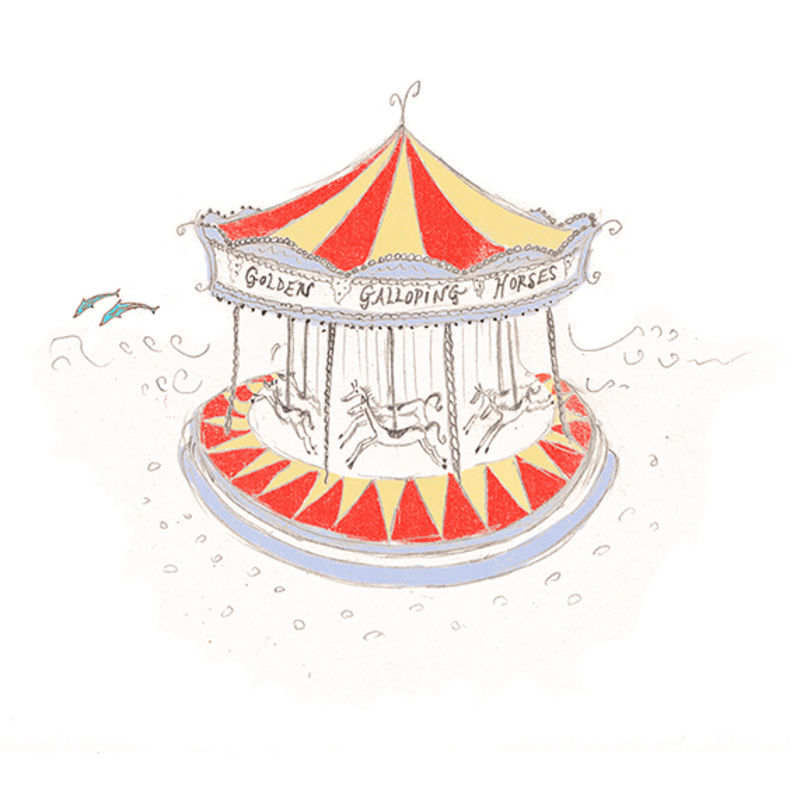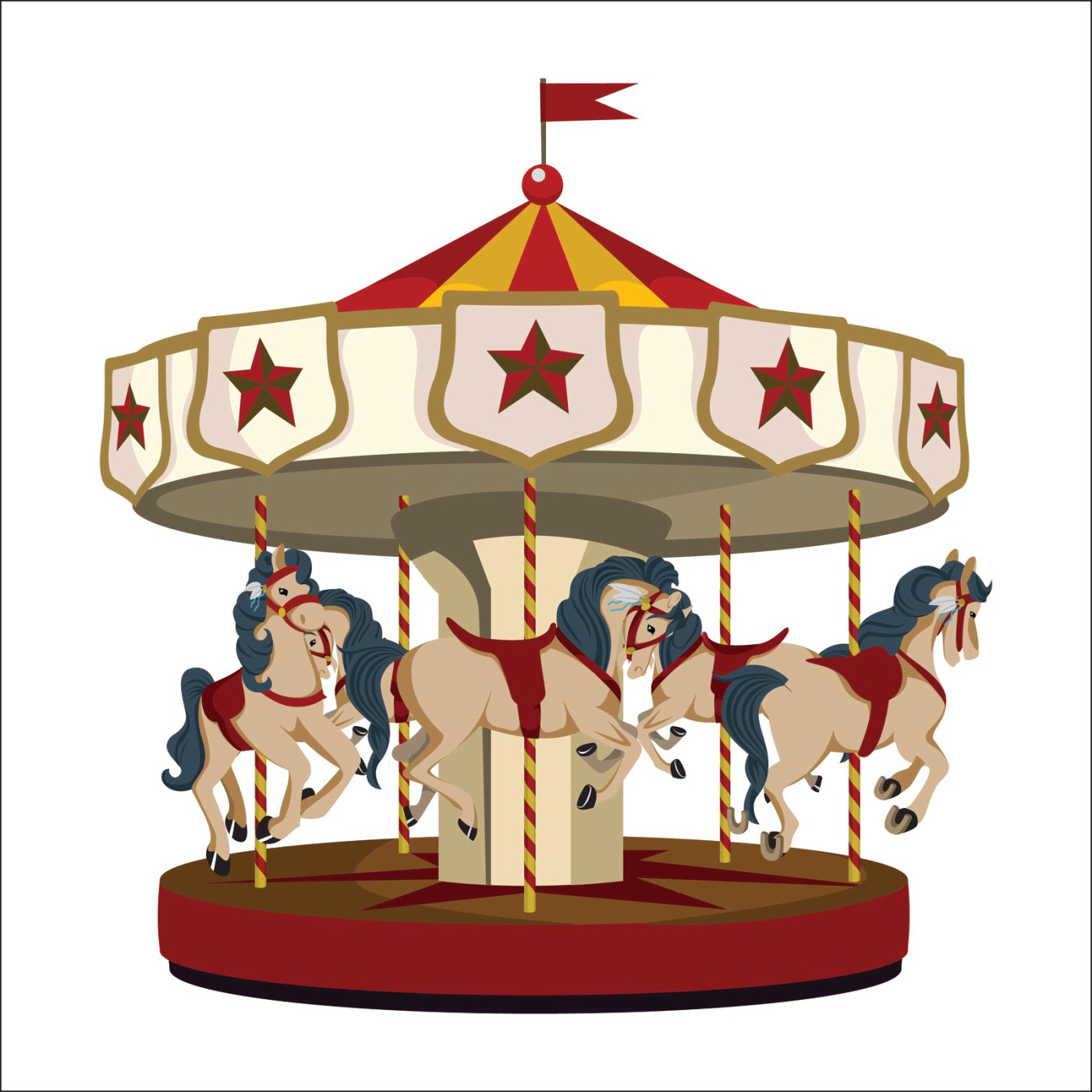A carousel or carrousel (mainly North American English), merry-go-round (international), galloper (international), or roundabout (British English) is a type of amusement ride consisting of a rotating circular platform with seats for riders. The seats are traditionally in the form of rows of animal figures (usually horses) mounted on posts. Many carousel animal figures move up and down to simulate galloping. Sometimes chair-like or bench-like seats are used, and occasionally mounts can take the form of non-animals, such as airplanes or cars. Carousel rides are typically accompanied by looped circus music. The word carousel derives from the French word carrousel and the Italian word carosello, both meaning little battle, a reference to its original purpose as a means of cavalry training.
History
Early carousels
The modern carousel emerged from early jousting traditions in Europe and the Middle East. Knights would gallop in a circle while tossing balls from one to another, an activity that required great skill and horsemanship. This game was introduced to Europe at the time of the Crusades from earlier Byzantine and Arab traditions. The word carousel originated from the Italian Carosella and Spanish Carosella meaning "little battle", which was used by crusaders to describe a combat preparation exercise and game played by Turkish and Arabian horsemen in the 12th century. This early device was essentially a cavalry training mechanism; it prepared and strengthened the riders for actual combat as they wielded their swords at mock enemies.
By the 17th century, balls were no longer used, and instead, the riders had to spear small rings that were hanging from poles overhead and rip them off. Cavalry spectacles that replaced medieval jousting, such as the ring tilt, were popular in Italy and France. The game began to be played by commoners, and carousels soon sprung up at fairgrounds across Europe. At the Place du Carrousel in Paris, an early make-believe carousel was set up with wooden horses for children. During this time in Belgium and France, the term "carousel" was applied to ceremonial parades of knights and noblemen on horseback circling around courtyards, accompanied by tournaments, various equestrian demonstrations, and games that included the spearing of cardboard heads of "Moors" and "Saracens." The most famous carousel of this kind was held by Louis XIV in June 1662, in the courtyard of the Tuileries Palace, to celebrate the birth of his son and heir. The site of the event, next to the Louvre, is still known as "the Carrousel."
By the early 18th century, carousels were being built and operated at various fairs and gatherings in central Europe and England. Animals and mechanisms would be crafted during the winter months and the family and workers would go touring in their wagon train through the region, operating their large menagerie carousel at various venues. Makers included Heyn in Germany and Bayol in France. These early carousels had no platforms; the animals would hang from chains and fly out from the centrifugal force of the spinning mechanism. They were often powered by animals walking in a circle or people pulling a rope or cranking.
Modern carousels
By the mid-19th century, the platform carousel was developed; ridable animal figures and chariots were fixed to a circular floor that would rotate around a central pole. These carousels were called dobbies and were operated manually by the operator or by ponies. Viewed from above, and from the riders' point of view, carousels in the United Kingdom, where they are also known as "gallopers," usually turn from left to right, or clockwise; while those in North America and Mainland Europe typically turn from right to left, or counterclockwise.
United Kingdom
By 1803, John Joseph Merlin had a carousel in his Mechanical Museum in London, where gentry and nobility liked to gather on winter evenings. The horses "floated free over a pole." It was connected to a "big musical instrument that played a fully orchestrated concerto" and from the first note, the carousel would start turning while each horse would make a galloping movement with a visitor riding on its back. Merlin did not patent his inventions and engineers were allowed to come to create their own models of his creations. By the mid-19th century, the carousel became a popular fixture at English fairs. The first steam-powered mechanical roundabout, invented by Thomas Bradshaw, appeared at the Pot Market fair in Bolton in about 1861. It was described by a Halifax Courier journalist as "a roundabout of huge proportions, driven by a steam engine which whirled around with such impetuosity, that the wonder is the daring riders are not shot off like cannonball, and driven half into the middle of next month."
Soon afterwards, English engineer Frederick Savage began to branch out of agricultural machinery production into the construction of fairground machines, swiftly becoming the chief innovator in the field. Savage's fairground machinery was exported all over the world. By 1870, he was manufacturing carousels with Velocipedes (an early type of bicycle) and he soon began experimenting with other possibilities, including a roundabout with boats that would pitch and roll on cranks with a circular motion, a ride he called 'Sea-on-Land'. Savage applied a similar innovation to the more traditional mount of the horse; he installed gears and offset cranks on the platform carousels, thus giving the animals their well-known up-and-down motion as they traveled around the central pole – the galloping horse. The platform served as a position guide for the bottom of the pole and as a place for people to walk or other stationary animals or chariots to be placed. He called this ride the 'Platform Gallopers'. He also developed the 'platform-slide' which allowed the mounts to swing out concentrically as the carousel built up speed. Fairground organs (band organs) were often present (if not built-in) when these machines operated. Eventually, electric motors and lights were installed, giving the carousel its classic look. These mechanical innovations came at a crucial time when increased prosperity meant that more people had time for leisure and had spare money to spend on entertainment. It was in this historical context that the modern fairground ride was born, with Savage supplying this new market demand. In his 1902 Catalogue for Roundabouts, he claimed to have "... patented and placed upon the market all the principal novelties that have delighted the many thousands of pleasure seekers at home and abroad."
United States
The first carousel on record in the United States was opened in the 1840s by Franz Wiesenoffer in Hessville, Ohio. On July 25, 1871, William Schneider of Davenport, Iowa, was issued the first American patent for a carousel, beginning the modern carousel industry in the country. To commemorate this milestone, July 25 was declared National Merry-Go-Round Day (a.k.a: National Carousel Day) in 2014 by the National Carousel Association (NCA), an organization focused on preserving historic carousels primarily in the United States and Canada.
The American carousel industry was developed by European immigrants, notably Danish immigrant Charles I. D. Looff, German immigrant Gustav Dentzel, and Scottish immigrant Allan Herschell. During the late 19th century, several carousel construction centers formed in the United States, each with their own style:
- Coney Island style – characterized by elaborate and sometimes faux-jeweled saddles, as well as mirrors to catch and reflect lights. This style was pioneered by Charles I. D. Looff in Brooklyn, New York City.
- Philadelphia style – known for more realistically painted saddles, this style was pioneered by Dentzel and the Philadelphia Toboggan Company.
- Country Fair style – often with no saddles at all, this style was pioneered by Allan Herschell and Edward Spillman of North Tonawanda, New York (near Buffalo), and Charles W. Parker of Kansas.
Notable extant carousels
Thousands of wood-carved carousels (possibly as many as 10,000) were built during their golden age from the 1870s to the early 1930s; less than 200 complete units exist today.: 10 Mechanical band organs that provided music, and brass ring dispensers that encouraged riders to sit on the outermost (often stationary) row, were common features for carousels during this time period, but are now very rare. Several notable carousels that exist today are recipients of the NCA's Historic Carousel Award.
Notable extant carousels built before 1870
Notable extant carousels built 1870–1939
Notable extant carousels built 1940–present
In popular culture
- The protagonist in the 1945 Broadway musical Carousel is a carousel barker.
- In the climactic scene of Alfred Hitchcock's 1951 film Strangers on a Train, the protagonist and antagonist struggle on a carousel.
- In the 1963 film Charade, there is a scene near its ending in which a carousel appears in the background with the main theme's music.
- In the 1964 Mary Poppins, Mary, Bert, and the two Banks children ride a carousel, whose carousel horses float off the platform and lead the riding characters to a fox hunt and horse race that Mary wins.
- The children's television program The Magic Roundabout, which aired from 1965 to 1977, uses a carousel as its central motif.
- The 1973 film The Sting features a large indoor carousel adjacent a brothel; the brothel's madam allows the prostitutes to ride it on slow nights.
- The House on the Rock carousel near Spring Green, Wisconsin, a rotating, display-only art piece built in 1981, has 269 carousel figures and is billed as the largest indoor carousel in the world.
- David Carradine's 1983 film Americana revolves around a Vietnam veteran's obsession with the restoration of an abandoned carousel.
- In the 1983 film Something Wicked This Way Comes, the carnival's steam carousel causes riders to become younger or older depending on the direction in which they ride.
- The children's television program Playdays had a carousel maintained by Mr. Jolly named Rosie, who was the focus of episodes broadcast from 1992 to 1997.
- In the 2011 Australian children's picture book The Carousel by Ursula Dubosarsky, after a carousel ride, a child has a semi-mystical vision of the carousel horses breaking free from the wheel and galloping across the world.
- In 2014, American singer-songwriter Melanie Martinez released the song "Carousel," using the word carousel as a metaphor for love that goes in circles endlessly.
- The three installments of the book series Kingdom Keepers: The Return by Ridley Pearson, published between 2015 and 2017, feature the carousel from Disneyland used as a time machine to arrive at the opening of Disneyland.
- The second song on Travis Scott's 2018 album Astroworld is named "Carousel."
Gallery
See also
- Amusement rides on the National Register of Historic Places
- Disney carousels
- Perron family
References
External links
- National Carousel Association – official website




